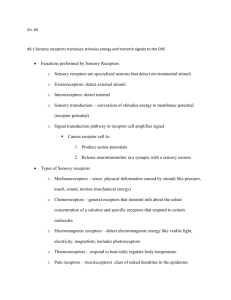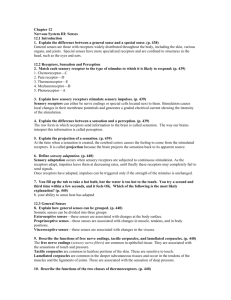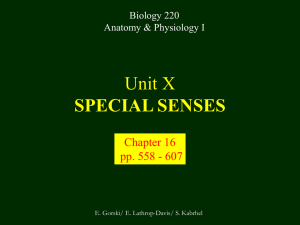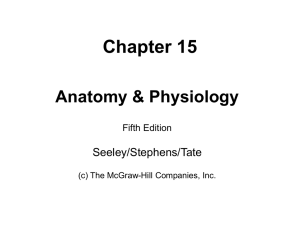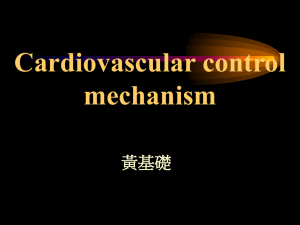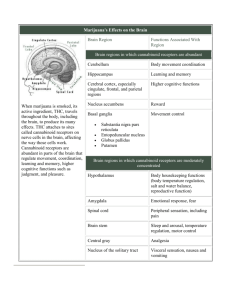Chapter 12
advertisement
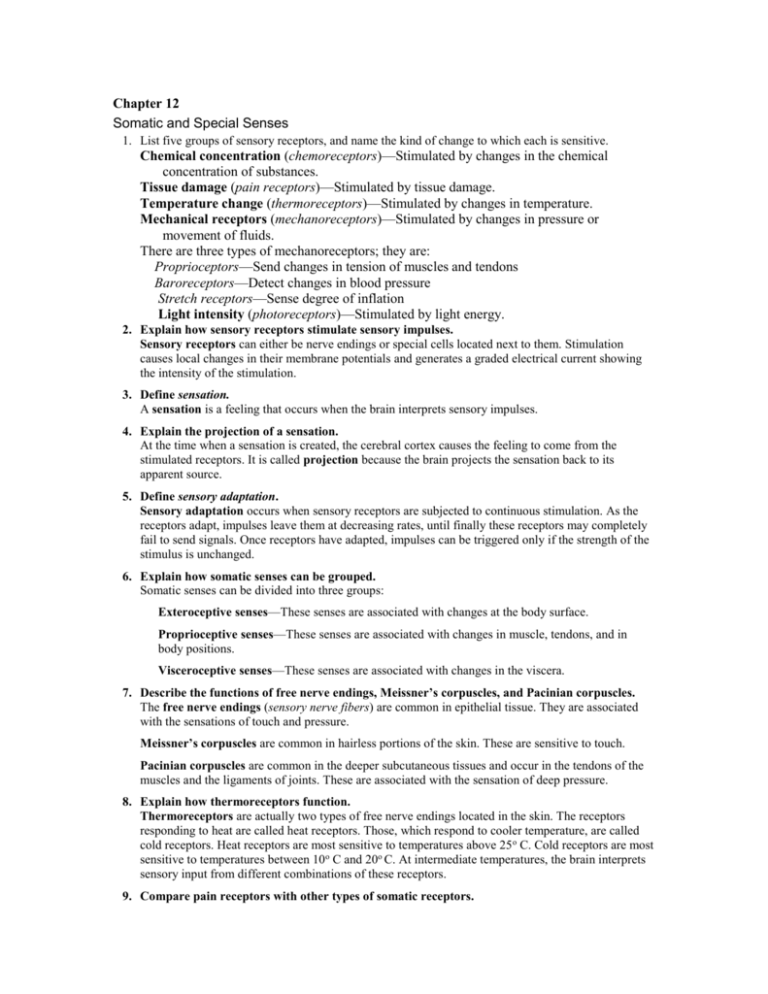
Chapter 12 Somatic and Special Senses 1. List five groups of sensory receptors, and name the kind of change to which each is sensitive. Chemical concentration (chemoreceptors)—Stimulated by changes in the chemical concentration of substances. Tissue damage (pain receptors)—Stimulated by tissue damage. Temperature change (thermoreceptors)—Stimulated by changes in temperature. Mechanical receptors (mechanoreceptors)—Stimulated by changes in pressure or movement of fluids. There are three types of mechanoreceptors; they are: Proprioceptors—Send changes in tension of muscles and tendons Baroreceptors—Detect changes in blood pressure Stretch receptors—Sense degree of inflation Light intensity (photoreceptors)—Stimulated by light energy. 2. Explain how sensory receptors stimulate sensory impulses. Sensory receptors can either be nerve endings or special cells located next to them. Stimulation causes local changes in their membrane potentials and generates a graded electrical current showing the intensity of the stimulation. 3. Define sensation. A sensation is a feeling that occurs when the brain interprets sensory impulses. 4. Explain the projection of a sensation. At the time when a sensation is created, the cerebral cortex causes the feeling to come from the stimulated receptors. It is called projection because the brain projects the sensation back to its apparent source. 5. Define sensory adaptation. Sensory adaptation occurs when sensory receptors are subjected to continuous stimulation. As the receptors adapt, impulses leave them at decreasing rates, until finally these receptors may completely fail to send signals. Once receptors have adapted, impulses can be triggered only if the strength of the stimulus is unchanged. 6. Explain how somatic senses can be grouped. Somatic senses can be divided into three groups: Exteroceptive senses—These senses are associated with changes at the body surface. Proprioceptive senses—These senses are associated with changes in muscle, tendons, and in body positions. Visceroceptive senses—These senses are associated with changes in the viscera. 7. Describe the functions of free nerve endings, Meissner’s corpuscles, and Pacinian corpuscles. The free nerve endings (sensory nerve fibers) are common in epithelial tissue. They are associated with the sensations of touch and pressure. Meissner’s corpuscles are common in hairless portions of the skin. These are sensitive to touch. Pacinian corpuscles are common in the deeper subcutaneous tissues and occur in the tendons of the muscles and the ligaments of joints. These are associated with the sensation of deep pressure. 8. Explain how thermoreceptors function. Thermoreceptors are actually two types of free nerve endings located in the skin. The receptors responding to heat are called heat receptors. Those, which respond to cooler temperature, are called cold receptors. Heat receptors are most sensitive to temperatures above 25 o C. Cold receptors are most sensitive to temperatures between 10o C and 20o C. At intermediate temperatures, the brain interprets sensory input from different combinations of these receptors. 9. Compare pain receptors with other types of somatic receptors. Most pain receptors can react to more than one type of change. In other words, pain receptors may react directly to mechanical damage, chemical changes, by-products of metabolism, ischemia, hypoxia, or stimulation of other receptors such as mechanoreceptor. So, pain receptors are not usually limited to the specific types of stimulation that other somatic receptors are. 10. List the factors that are likely to stimulate visceral pain receptors. Factors that stimulate visceral pain receptors include: widespread stimulation of visceral tissues, stimulation of mechanoreceptors, and decrease blood flow accompanied by lower oxygen concentration and accumulation of pain-stimulating chemicals. 11. Define referred pain. Referred pain is a phenomenon that occurs when the pain feels as if it is coming from some part of the body other than the part being stimulated. An example would be pain that originates from the heart may actually be felt in the left shoulder or left arm. 12. Explain how neuropeptides relieve pain. Neuropeptides called enkephalins and monoamine serotonin inhibit pain sensations by blocking the impulses from the presynaptic nerve fibers in the spinal cord. Enkephalins suppress both acute and chronic pain impulses much like morphine does. Serotonin stimulates other neurons to release enkephalins. Another group of neuropeptides are the endorphins. They are found in the pituitary gland, hypothalamus, and other regions of the nervous system. These act as pain suppressor with a morphine-like action. 13. Distinguish between muscle spindles and Golgi tendon organs. Muscle spindles are found in skeletal muscles near their junctions with tendons. Each spindle contains one or more modified skeletal muscle fibers enclosed in connective muscle tissue. Each fiber has a non-striated region with the end of a sensory nerve fiber wrapped around it. Golgi tendon organs are found in the tendons close to their muscle attachment and each is connected to a set of muscle fibers and innervated by a sensory neuron. 14. Explain how the senses of smell and taste function together to create the flavors of foods. Both olfactory and taste receptors are sensitive to chemical sensations. Because of this, we smell the food at the same time we taste it. Often, it is impossible to tell whether the sensation is mostly from the smell of a food or from the actual taste. 15. Describe the olfactory organ and its function. The olfactory organs include yellowish-brown masses of olfactory receptor cells and epithelial supporting cells all wrapped by a mucous membrane. They are found in the superior parts of the nasal cavity, superior nasal conchae, and part of the nasal septum. They function to provide the sense of smell. 16. Trace a nerve impulse from the olfactory receptor to the interpreting centers of the brain. An olfactory receptor that has been stimulated causes nerve impulses to be triggered and travel along the axons of the receptor cells that are the fibers of the olfactory nerves. These fibers lead to neurons located in the olfactory bulbs that like on either side of the crista galli of the ethmoid bone. In the olfactory bulbs, the impulses are analyzed and additional impulses are located within the temporal lobes and at the base of the frontal lobes just anterior to the hypothalamus. 17. Explain how an olfactory code distinguishes odor stimuli. Although the mechanism is unknown, certain subsets of receptors may only be stimulated by a certain odor. The brain then will interpret those specific receptors stimulated to a specific odor. 18. Explain how the salivary glands aid the taste receptors. Before the taste of a particular chemical can be detected, the chemical must be dissolved in the watery fluid surrounding the taste buds. This fluid is supplied by the salivary glands. 19. Name the four primary taste sensations, and describe the patterns in which the taste receptors are roughly distributed on the tongue. Sweet as produced by table sugar. These receptors are most plentiful near the tip of the tongue. Sour as produced by vinegar. These receptors occur primarily along the margins of the tongue. Salty as produced by table salt. These receptors are most abundant in the tip and the upper front part of the tongue. Bitter as produced by caffeine or quinine. These receptors are located toward the back of the tongue. 20. Explain why taste sensation is less likely to diminish with age than olfactory sensation. This is due to the fact that the taste cells reproduce continually and only function for about three days. Damaged olfactory neurons are not replaced. 21. Trace the pathway of a taste impulse from the receptor to the cerebral cortex. Sensory impulses from the taste receptors located in various regions of the tongue travel on fibers of the facial, glossopharyngeal, and vagus nerves into the medulla oblongata. From there, the impulses ascend to the thalamus and are directed to the gustatory cortex, which is located in the parietal lobe of the cerebrum along a deep portion of the lateral sulcus. 22. Distinguish among the external, middle, and inner ears. The external ear consists of two parts: an outer funnel-like structure, called the auricle or pinna, and S-shaped tube, called the external auditory meatus, which leads into the temporal bone for about 2.5 centimeters. The middle ear includes an air-filled space in the temporal bone, called the tympanic cavity, tympanic membrane (eardrum), and three small bones called auditory ossicles. These bones are the malleus (hammer), incus (anvil), and stapes (stirrup). The inner ear consists of a complex system of intercommunicating chambers and tubes called a labyrinth. There are, in fact, two such structures in each ear—the osseous labyrinth and the membranous labyrinth. Perilymph is a fluid that is between the two labyrinths. It also includes three semi-circular canals and cochlea. 23. Trace the path of a sound vibration from the tympanic membrane to the hearing receptors. The sound waves enter the external auditory meatus. Changes of wave pressures cause the eardrum to reproduce the vibrations coming from the sound wave source. Auditory ossicles amplify and transmit the vibrations to the end of the stapes. Movement of the stapes at the oval window transmits vibrations to the perilymph in the scala vestibuli. Vibrations pass through the vestibular membrane and enter the endolymph of the cochlear duct. Different frequencies in the endolymph stimulate different sets of receptor cells. 24. Describe the functions of the auditory ossicles. The bones form a bridge connecting the tympanic membrane to the inner ear. They function to transmit vibrations between these parts. 25. Describe the tympanic reflex, and explain its importance. The tympanic reflex consists of two skeletal muscles associated with the middle ear that are controlled involuntarily. The reflex is elicited by long, external sounds causing the bridge of the ossicles to become more rigid, reducing its effectiveness in transmitting vibrations to the inner ear. The tympanic reflex reduces pressure from loud sounds that might otherwise damage the hearing receptors. 26. Explain the function of the auditory tube. The function of the auditory tube (Eustachian tube) is to maintain equal air pressure on both sides of the tympanic membrane, which is necessary for normal hearing. 27. Distinguish between the osseous and the membranous labyrinths. The osseous labyrinth is a bony canal in the temporal bone. The membranous labyrinth is a tube that lies within the osseous labyrinth and has a similar shape. 28. Describe the cochlea and its function. The cochlea contains a bony core and a thin bony shelf that winds around the core like the threads of a screw. It functions in hearing by allowing the sound vibrations from the perilymph to travel along the scala vestibuli and pass through the vestibular membrane and into the endolymph of the cochlear duct where they cause movements in the basilar membrane. It then stimulates the organ of Corti, which contains the hearing receptors. 29. Describe a hearing receptor. A hearing receptor cell is an epithelial cell. These cells act like a neuron. The cell membrane is polarized when the cell is at rest. Upon stimulation the cell membrane depolarizes and the ion channels open. This makes the membrane more permeable to calcium. The cell releases a neurotransmitter that stimulates the nearby sensory nerve fibers, and they transmit impulses along the cochlear branch of the vestibulocochlear nerve to the auditory cortex of the temporal lobe of the brain. 30. Explain how a hearing receptor stimulates a sensory neuron. The cell releases a neurotransmitter that stimulates the nearby sensory nerve fibers, and they transmit impulses along the cochlear branch of the vestibulocochlear nerve to the auditory cortex of the temporal lobe of the brain. 31. Trace a nerve impulse from the organ of Corti to the interpreting centers of the cerebrum. Once the sound is converted into a nerve impulse at the organ of Corti, it travels along the cochlear branch of the vestibulocochlear nerve to the auditory cortex of the temporal lobe of the brain. On the way, some of the nerve branches cross over, so that impulses from both ears will be interpreted by both sides of the brain. 32. Describe the organs of static and dynamic equilibrium and their functions. The organs of static equilibrium are located within the vestibule, a bony chamber between the semicircular canals and cochlea. The membranous labyrinth inside the vestibule consists of two expanded chambers—an utricle and a saccule. The macula is on the anterior wall of the utricle that contains numerous hair cells and supporting cells. These sense the positions of the head and help in maintaining the stability and posture of the head and body when these parts are motionless. The organs of dynamic equilibrium are located within the three semicircular canals. Suspended in the perilymph of the bony portion of each semicircular canal is a membranous canal that ends in a swelling called the ampulla. The sensory organs are located here. These organs are called the crista ampullaris and contain a number of hair cells and supporting cells. These function to detect motion of the head and aid in balancing the head and body when they are moved suddenly. 33. Explain how the sense of vision helps maintain equilibrium. The eyes detect the body’s position relative to its surroundings. For this reason, the eyes help the brain maintain equilibrium, especially if the other organs of equilibrium are damaged. 34. List the visual accessory organs, and describe the functions of each. Eyelids—protection of the eye Lacrimal apparatus—secretions keep the surface of the eye and the lining of the lids moist and lubricated. An enzyme within the tears functions as an antibacterial agent, reducing the chance of eye infections. Extrinsic muscles—movement of the eye 35. Name the three layers of the eye wall, and describe the functions of each. Outer fibrous tunic—serves as the cornea and sclera. The cornea functions as a window to the eye and helps focus entering light rays. The sclera provides protection and serves as an attachment for the extrinsic muscles Middle vascular tunic—includes the choroid coat, which helps to absorb excess light so the inside of the eye is dark; the ciliary body, which forms the ciliary muscles and processes; and the iris, whose smooth muscle control the pupil size. Inner nervous tunic—consists of the retina, which contains the visual receptor cells. 36. Describe how accommodation is accomplished. Accommodation results from the suspensory ligaments either relaxing or pulling due to decreased or increased tension from the suspensory muscles. This allows people to see objects either close up or more distant. 37. Explain how the iris functions. The smooth muscle fibers of the iris are arranged into two groups, a circular set and a radial set. The circular muscles act as a sphincter to decrease pupil size. The radial muscles contract to increase the diameter of the pupil. 38. Distinguish between aqueous humor and vitreous humor. The aqueous humor fills the space between the cornea and lens, helps to nourish these parts, and aids in maintaining the shape of the front of the eye. The vitreous humor fills the posterior cavity, and together with some collagenous fibers, comprises the vitreous body. This supports the internal parts of the eye and helps maintain its shape. 39. Distinguish between the macula lutea and optic disk. The macula lutea is a small spot on the retina. In its center is a depression called the fovea centralis, which has the sharpest vision. The optic disk is just medial to the macula lutea and is the area where the optic nerve begins and blood vessels enter and exit. This area has no receptors, and is known as the blind spot of the eye. 40. Explain how light waves focus on the retina. As light enters the eye, it is refracted, or bent, by the cornea and lens and is focused sharply on the retina. The image is projected upside down and reversed from left to right. The visual cortex somehow corrects this when it interprets the images. 41. Distinguish between rods and cones. Rods are receptor cells that have long thin projections at their terminal ends. Rods are hundreds of times more sensitive to light than cones. This enables people to see in relatively dim light. Rods produce colorless vision. Cones are receptor cells that have short, blunt projections. Cones allow for increased visual acuity— the sharpness of images perceived. Cones make up the entire fovea centralis. Cones also detect colors of light. 42. Explain why cone vision is generally more acute than rod vision. When the images are being sent from the rods and cones to the brain, the nerve fibers of the rods converge and send all of the images on a single tract. The brain can interpret the images, but cannot tell specifically from which rod a particular part came from. The cones converge their nerve fibers to a much lesser degree. This allows the brain to interpret the images more accurately and sharply. 43. Describe the function of rhodopsin. Rhodopson (visual purple) is the light-sensitive substance in the rods. Bright light decomposes rhodopsin rapidly so the sensitivity in the rods is greatly reduced. Thus, this pigment allows us to see in dim light. 44. Explain how the eye adapts to light and dark. Light comes in the form of many different wavelengths. The color perceived is an interpretation of its specific wavelength. The shortest visible wavelengths are perceived as violet. The longest is perceived as red. The cones are designed to be stimulated by one of three different visual pigments. An erythrolabe cone is sensitive to red light waves, a chlorolabe to green light waves, and a cyanolabe to blue light waves. In this way the combinations of light waves entering the eye can be detected by the cones and relayed to the brain. 45. Describe the relationship between light wavelengths and color vision. The wavelength of a particular kind of light determines the color perceived. The cones in the eyes each have a certain pigment that is stimulated by certain wavelengths. Some cones have erythrolabe pigment that is sensitive to red light waves, some have chlorolabe which is sensitive to green, and some have cyanolabe which is sensitive to blue. The combinations of these stimulations gives us color vision. 46. Define stereoscopic vision. Steropsis allows a person with binocular vision (using both eyes) to perceive distance, depth, width, and height of an object. 47. Explain why a person with binocular vision is able to judge distance and depth of close objects more accurately than a one-eyed person. This happens because the eyes are separated and see slightly more of one side than the other (the left eye sees more left and the right eye sees more right). The impulses are superimposed in the brain and gives us a three-dimensional view of the object. A person using only one eye cannot see “both sides” of the object at the same time. Thus, the object appears two-dimensional. 48. Trace a nerve impulse from the retina to the visual cortex. The axons of the retinal neurons for the optic nerves. These nerves enter the X-shaped optic chiasma just anterior to the pituitary gland and the fibers from the medial (nasal) half cross over (the lateral or temporal sides do not). For instance, the nerves from the nasal half of the left eye cross over and join the temporal half of the right eye to form the right optic tract. The nasal half of the right eye crosses over and joins the temporal half of the left eye to form the left optic tract. The impulses travel these tracts until just before the thalamus, when some of the nerve fibers branch off and enter the areas that control visual reflexes. The rest enter the thalamus and synapse in the posterior portion (lateral geniculate body) and continue on through the optic radiations into the visual cortex in the occipital lobes.
